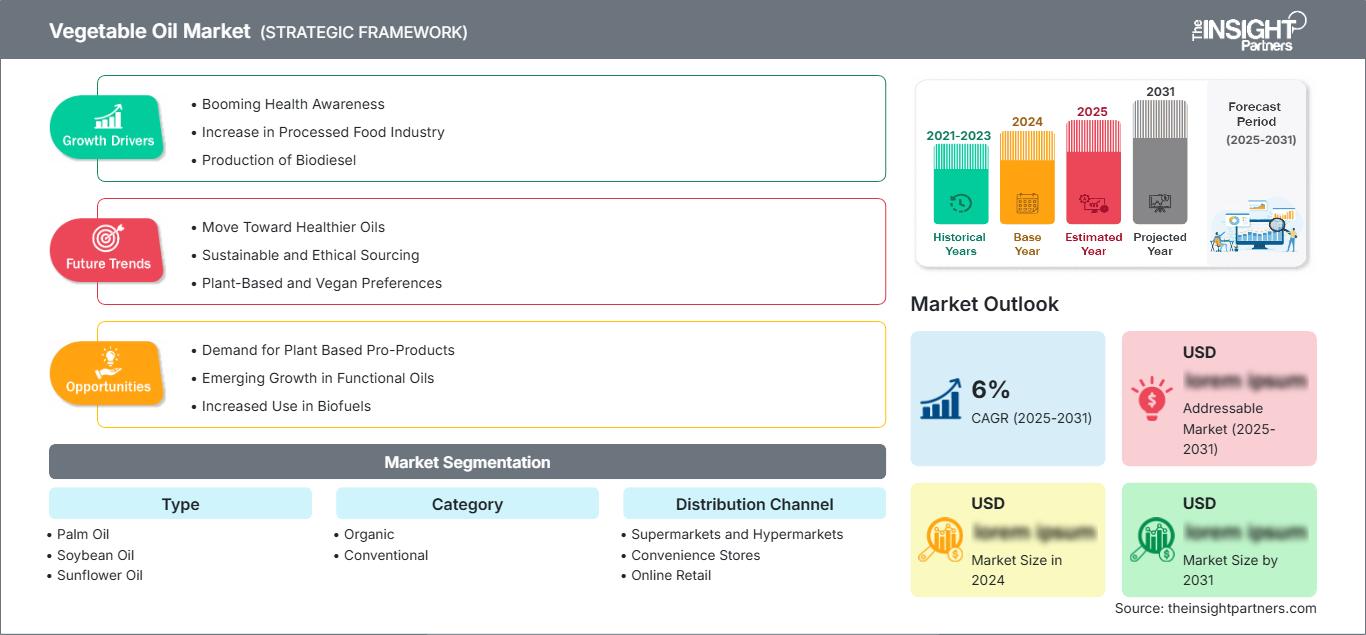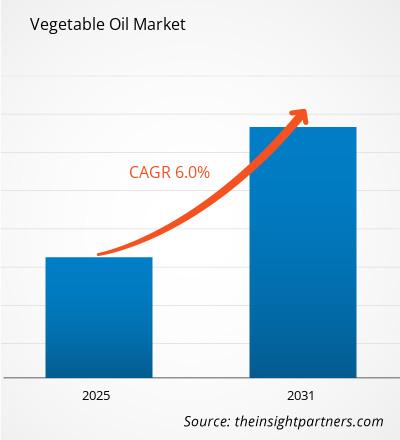Der Markt für Pflanzenöle wird voraussichtlich zwischen 2025 und 2031 eine durchschnittliche jährliche Wachstumsrate (CAGR) von 6 % verzeichnen, wobei die Marktgröße von XX Millionen US-Dollar im Jahr 2024 auf XX Millionen US-Dollar im Jahr 2031 anwachsen wird.
Der Bericht ist nach Typ (Palmöl, Sojaöl, Sonnenblumenöl, Olivenöl, Kokosöl, sonstige) und Kategorie (biologisch, konventionell) segmentiert. Der Bericht präsentiert außerdem eine Analyse basierend auf dem Vertriebskanal (Supermärkte und Verbrauchermärkte, Convenience Stores, Online-Einzelhandel und sonstige). Die globale Analyse ist weiter auf regionaler Ebene und nach den wichtigsten Ländern aufgeschlüsselt. Geografisch ist der Markt in Nordamerika, Europa, Asien-Pazifik, Naher Osten und Afrika sowie Süd- und Mittelamerika unterteilt. Der Bericht bietet den Wert in USD für die oben genannte Analyse und Segmente.
Zweck des Berichts
Der Bericht „Pflanzenölmarkt“ von The Insight Partners zielt darauf ab, die aktuelle Situation und das zukünftige Wachstum sowie die wichtigsten treibenden Faktoren, Herausforderungen und Chancen zu beschreiben. Dadurch erhalten verschiedene Geschäftsinteressenten Einblicke, beispielsweise:
- Technologieanbieter/-hersteller: Um die sich entwickelnde Marktdynamik zu verstehen und die potenziellen Wachstumschancen zu kennen, sodass sie fundierte strategische Entscheidungen treffen können.
- Investoren: Um eine umfassende Trendanalyse hinsichtlich der Marktwachstumsrate, der finanziellen Marktprognosen und der Chancen entlang der Wertschöpfungskette durchzuführen.
- Regulierungsbehörden: Um Richtlinien und Überwachungsaktivitäten auf dem Markt zu regulieren, mit dem Ziel, Missbrauch zu minimieren, das Vertrauen der Investoren zu wahren und die Integrität und Stabilität des Marktes aufrechtzuerhalten.
Pflanzenöl Marktsegmentierung Typ
- Palmöl
- Sojaöl
- Sonnenblumenöl
- Olivenöl
- Kokosöl
- Sonstige
Kategorie
- Bio
- Konventionell
Vertriebskanal
- Supermärkte und Hypermärkte
- Convenience Stores
- Online-Einzelhandel
- Sonstige
Geografie
- Nordamerika
- Europa
- Asien-Pazifik
- Süd- und Mittelamerika
- Naher Osten und Afrika
Sie erhalten kostenlos Anpassungen an jedem Bericht, einschließlich Teilen dieses Berichts oder einer Analyse auf Länderebene, eines Excel-Datenpakets sowie tolle Angebote und Rabatte für Start-ups und Universitäten.
Pflanzenölmarkt: Strategische Einblicke

-
Holen Sie sich die wichtigsten Markttrends aus diesem Bericht.Dieses KOSTENLOSE Beispiel umfasst Datenanalysen, die von Markttrends bis hin zu Schätzungen und Prognosen reichen.
Wachstumstreiber für Pflanzenöle
- Steigendes Gesundheitsbewusstsein: Das Gesundheitsbewusstsein der Verbraucher steigt und die Nachfrage nach Pflanzenölen mit gesunden Fettsäuren wie Oliven- und Rapsöl steigt. Diese Öle sollen eine herzgesunde Ernährung unterstützen, da sie tierische Fette ersetzen, was die Marktentwicklung von Pflanzenölen vorantreibt.
- Zunahme in der Lebensmittelindustrie: Die Lebensmittelindustrie hat die Nachfrage nach Pflanzenölen erhöht. Diese Öle finden Anwendung beim Kochen, Braten und in vielen anderen Bereichen, beispielsweise als Snack, Fertiggericht und Backzutat, was zu einem verstärkten Wachstum in diesem Sektor führt.
- Biodieselproduktion: Der zunehmende Trend zur Verwendung von Pflanzenölen für die Biodieselproduktion hat erheblich zum Marktwachstum beigetragen. Der von Regierungen eingeleitete Übergang zu erneuerbaren Energiequellen und saubereren Kraftstoffen hat die Verwendung von Pflanzenölen zur Herstellung von Biokraftstoffen gefördert und damit deren Anwendung über die Verwendung in Lebensmitteln hinaus erweitert, beispielsweise für Biodiesel aus Soja- und Palmöl.
Zukünftige Trends auf dem Pflanzenölmarkt
- Weg zu gesünderen Ölen: Es gibt einen verstärkten Trend zur Verwendung von Fetten wie Avocado-, Oliven- und Leinsamenöl. Verbraucher bevorzugen heute Öle mit einem geringen Anteil gesättigter Fettsäuren und einem hohen Anteil an Omega-3-Fettsäuren aus Gesundheitsgründen und im Bewusstsein für die Herz-Kreislauf-Gesundheit.
- Nachhaltige und ethische Beschaffung: Da Verbraucher zunehmend nachhaltig und ethisch beschafften Produkten den Vorzug geben, stellt die Pflanzenölindustrie auf nachhaltige Palmölproduktion und deren Zertifizierung – à la RSPO – um, die nun auch umweltfreundliche Verfahren für Verbraucher umfasst. Dieser Trend führt zu weniger abgeholzten Wäldern und verbesserten Umweltbedingungen für den Ölanbau.
- Präferenzen für pflanzliche und vegane Produkte: Die zunehmende Präferenz für pflanzliche Lebensmittel treibt das Geschäft mit Pflanzenölen voran, auch in den Kategorien pflanzliche und vegane Produkte. Beispiele sind Kokosnuss-, Raps- und Sojaöl, die vor allem von Veganern und Vegetariern zum Kochen, Backen oder Zubereiten von Speisen gewählt werden.
Marktchancen für Pflanzenöle
- Nachfrage nach pflanzlichen Profiprodukten: Diese sind sehr beliebt und die entsprechende Nachfrage der Branche wächst. Insbesondere Pflanzenöle wie Avocado-, Sonnenblumen- und Rapsöl bieten Chancen, zu den wichtigsten Akteuren im Bereich veganer und pflanzlicher Lebensmittel zu werden.
- Aufstrebendes Wachstum bei funktionellen Ölen: Dies eröffnet Chancen auf dem Pflanzenölmarkt, da funktionelle Öle mit zusätzlichem gesundheitlichen Nutzen gefragt sind. Mit Omega-3-Fettsäuren, Antioxidantien und Vitaminen angereicherte Öle erfreuen sich aufgrund ihrer gesundheitsfördernden Wirkung – wie der entzündungshemmenden und herzgesunden Wirkung – zunehmender Beliebtheit.
- Verstärkte Nutzung in Biokraftstoffen: Mit der zunehmenden Fokussierung auf erneuerbare Energiequellen erhalten Pflanzenöle ihren Anteil an der Biokraftstoffproduktion. Daher können Ölproduzenten ihre Märkte erweitern, Öle wie Soja- und Palmöl für Biokraftstoffe liefern und Nachhaltigkeitsziele im Energiesektor erreichen.
Pflanzenölmarkt
Die Analysten von The Insight Partners haben die regionalen Trends und Faktoren, die den Pflanzenölmarkt im Prognosezeitraum beeinflussen, ausführlich erläutert. In diesem Abschnitt werden auch die Marktsegmente und die geografische Lage in Nordamerika, Europa, dem asiatisch-pazifischen Raum, dem Nahen Osten und Afrika sowie Süd- und Mittelamerika erörtert.Umfang des Pflanzenölmarktberichts
| Berichtsattribut | Einzelheiten |
|---|---|
| Marktgröße in 2024 | US$ XX million |
| Marktgröße nach 2031 | US$ XX Million |
| Globale CAGR (2025 - 2031) | 6% |
| Historische Daten | 2021-2023 |
| Prognosezeitraum | 2025-2031 |
| Abgedeckte Segmente |
By Typ
|
| Abgedeckte Regionen und Länder |
Nordamerika
|
| Marktführer und wichtige Unternehmensprofile |
|
Dichte der Akteure auf dem Pflanzenölmarkt: Auswirkungen auf die Geschäftsdynamik verstehen
Der Pflanzenölmarkt wächst rasant, angetrieben durch die steigende Endverbrauchernachfrage aufgrund von Faktoren wie veränderten Verbraucherpräferenzen, technologischem Fortschritt und einem stärkeren Bewusstsein für die Produktvorteile. Mit steigender Nachfrage erweitern Unternehmen ihr Angebot, entwickeln Innovationen, um den Verbraucherbedürfnissen gerecht zu werden, und nutzen neue Trends, was das Marktwachstum weiter ankurbelt.

- Holen Sie sich die Pflanzenölmarkt Übersicht der wichtigsten Akteure
Wichtige Verkaufsargumente
- Umfassende Abdeckung: Der Bericht analysiert umfassend Produkte, Dienstleistungen, Typen und Endverbraucher des Pflanzenölmarkts und bietet einen ganzheitlichen Überblick.
- Expertenanalyse: Der Bericht basiert auf dem umfassenden Verständnis von Branchenexperten und Analysten.
- Aktuelle Informationen: Der Bericht gewährleistet Geschäftsrelevanz durch die Berichterstattung über aktuelle Informationen und Datentrends.
- Anpassungsoptionen: Dieser Bericht kann an spezifische Kundenanforderungen angepasst werden und passt sich so optimal an die Geschäftsstrategien an.
Der Forschungsbericht zum Pflanzenölmarkt kann daher dabei helfen, die Branchensituation und die Wachstumsaussichten zu entschlüsseln und zu verstehen. Obwohl es einige berechtigte Bedenken geben mag, überwiegen die Vorteile dieses Berichts tendenziell die Nachteile.
- Historische Analyse (2 Jahre), Basisjahr, Prognose (7 Jahre) mit CAGR
- PEST- und SWOT-Analyse
- Marktgröße Wert/Volumen – Global, Regional, Land
- Branchen- und Wettbewerbslandschaft
- Excel-Datensatz
Aktuelle Berichte
Verwandte Berichte
Erfahrungsberichte
Grund zum Kauf
- Fundierte Entscheidungsfindung
- Marktdynamik verstehen
- Wettbewerbsanalyse
- Kundeneinblicke
- Marktprognosen
- Risikominimierung
- Strategische Planung
- Investitionsbegründung
- Identifizierung neuer Märkte
- Verbesserung von Marketingstrategien
- Steigerung der Betriebseffizienz
- Anpassung an regulatorische Trends






















 Kostenlose Probe anfordern für - Pflanzenölmarkt
Kostenlose Probe anfordern für - Pflanzenölmarkt